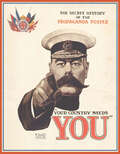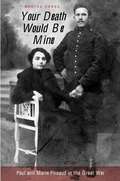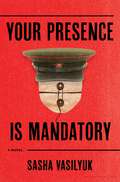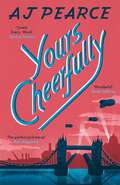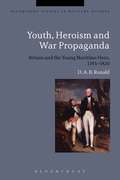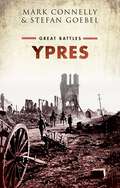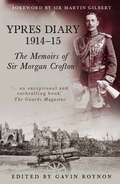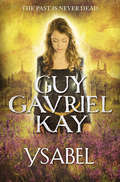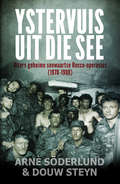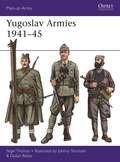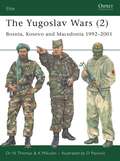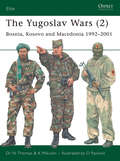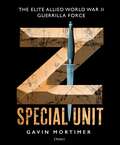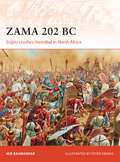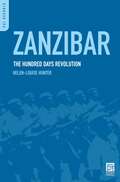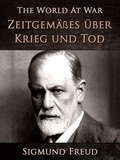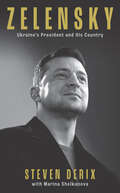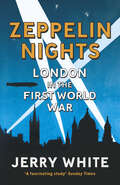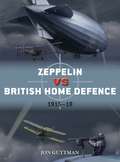- Table View
- List View
Your Country Needs You: The Secret History of the Propaganda Poster
by James TaylorThe iconic image by Alfred Leete of Lord Kitchener with outstretched hand and finger, exhorting you to 'do your bit', is a design classic and has been repeatedly imitated worldwide. In the run-up to the World War I anniversary, Your Country Needs YOU celebrates the magnificent artwork of Leete and his fellow designers, and explores their legacy. Featuring colour reproductions of propaganda posters and drawing on fresh analysis of the archives, this book challenges received historical wisdom about these hugely popular and enduring images, and reveals surprising new insights
Your Death Would Be Mine: Paul and Marie Pireaud in the Great War
by Martha HannaPaul and Marie Pireaud, a young peasant couple from southwest France, were newlyweds when World War I erupted. With Paul in the army from 1914 through 1919, they were forced to conduct their marriage mostly by correspondence. Drawing upon the hundreds of letters they wrote, Martha Hanna tells their moving story and reveals a powerful and personal perspective on war. Civilians and combatants alike maintained bonds of emotional commitment and suffered the inevitable miseries of extended absence. While under direct fire at Verdun, Paul wrote with equal intensity and poetic clarity of the brutality of battle and the dietary needs (as he understood them) of his pregnant wife. Marie, in turn, described the difficulties of working the family farm and caring for a sick infant, lamented the deaths of local men, and longed for the safe return of her husband. Through intimate avowals and careful observations, their letters reveal how war transformed their lives, reinforced their love, and permanently altered the character of rural France. Overwhelmed by one of the most tumultuous upheavals of the modern age, Paul and Marie found solace in family and strength in passion. Theirs is a human story of loneliness and longing, fear in the face of death, and the consolations of love. Your Death Would Be Mine is a poignant tale of ordinary people coping with the trauma of war.
Your Presence Is Mandatory: A Novel
by Sasha VasilyukA riveting debut novel, based on real events, about a World War II veteran with a secret that could land him in the Gulag, and his family who are forced to live in the shadow of all he has not told them.Ukraine, 2007. Yefim Shulman, husband, grandfather and war veteran, was beloved by his family and his coworkers. But in the days after his death, his widow Nina finds a letter to the KGB in his briefcase. Yefim had a lifelong secret, and his confession forces them to reassess the man they thought they knew and the country he had defended.In 1941, Yefim is a young artillerist on the border between the Soviet Union and Germany, eager to defend his country and his large Jewish family against Hitler's forces. But surviving the war requires sacrifices Yefim never imagined-and even when the war ends, his fight isn't over. He must conceal his choices from the KGB and from his family. Spanning seven decades between World War II and the current Russia-Ukraine conflict, Your Presence Is Mandatory traces the effect Yefim's coverup had on the lives of Nina, their two children and grandchildren. In the process, Sasha Vasilyuk shines a light on one family caught between two totalitarian regimes, and the grace they find in the course of their survival.
Yours Cheerfully: an inspirational story of wartime friendship from the author of Dear Mrs Bird (The Wartime Chronicles #2)
by AJ PearceComforting, charming and hilarious, Yours Cheerfully is the tonic we've all been waiting for, from AJ Pearce, the beloved author of Dear Mrs Bird.‘Loved. Every. Word.' - Bonnie Garmus, author of Lessons in ChemistryLondon, September 1941. For plucky, determined Emmy Lake, working at Woman’s Friend magazine has become everything she dreamed, especially since the departure of the magazine’s formidable editor, Henrietta Bird. Now Emmy really can get on and Do Her Bit.When the Ministry of Information calls on Woman’s Friend to help recruit female supporters to the war effort, Emmy is thrilled, but soon she and best friend Bunty meet a young woman who shows them the real challenges that women war workers face. Suddenly Emmy must tackle a life-changing dilemma: should she carry out her duty or stand by her friends?'Absolutely lovely!' – Marian Keyes'Buoyant . . . a tonic in testing times' – Mail on Sunday'A brilliant follow up to Dear Mrs Bird' – Clare Mackintosh'Full of wit, friendship and the uplifting knowledge that when people come together, great changes can be made' – Katie Fforde
Youth, Heroism and War Propaganda: Britain and the Young Maritime Hero, 1745-1820 (Bloomsbury Studies in Military History)
by D. A. RonaldYouth, Heroism and Naval Propaganda explores how the young maritime hero became a major new figure of war propaganda in the second half of the long eighteenth century. At that time, Britain was searching for a new national identity, and the young maritime hero and his exploits conjured images of vigour, energy, enthusiasm and courage. Adopted as centrepiece in a campaign of concerted war-propaganda leading up to the Battle of Trafalgar, the young hero came to represent much that was quintessentially British at this major turning-point in the Nation's history. By drawing on a wide range of sources, this study shows how the young hero gave maritime youth a symbolic power which it had never before had in Britain. It offers a valuable contribution to the field of British military and naval history, as well as the study of British identity, youth, heroism and propaganda.
Youth, Heroism and War Propaganda: Britain and the Young Maritime Hero, 1745-1820 (Bloomsbury Studies in Military History)
by D. A. RonaldYouth, Heroism and Naval Propaganda explores how the young maritime hero became a major new figure of war propaganda in the second half of the long eighteenth century. At that time, Britain was searching for a new national identity, and the young maritime hero and his exploits conjured images of vigour, energy, enthusiasm and courage. Adopted as centrepiece in a campaign of concerted war-propaganda leading up to the Battle of Trafalgar, the young hero came to represent much that was quintessentially British at this major turning-point in the Nation's history. By drawing on a wide range of sources, this study shows how the young hero gave maritime youth a symbolic power which it had never before had in Britain. It offers a valuable contribution to the field of British military and naval history, as well as the study of British identity, youth, heroism and propaganda.
Ypres: Great Battles (Great Battles)
by Mark Connelly Stefan GoebelIn 1914, Ypres was a sleepy Belgian city admired for its magnificent Gothic architecture. The arrival of the rival armies in October 1914 transformed it into a place known throughout the world, each of the combatants associating the place with it its own particular palette of values and imagery. It is now at the heart of First World War battlefield tourism, with much of it's economy devoted to serving the interests of visitors from across the world. The surrounding countryside is dominated by memorials, cemeteries, and museums, many of which were erected in the 1920s and 1930s, but the number of which are being constantly added to as fascination with the region increases. Mark Connelly and Stefan Goebel explore the ways in which Ypres has been understood and interpreted by Britain and the Commonwealth, Belgium, France, and Germany, including the variants developed by the Nazis, looking at the ways in which different groups have struggled to impose their own narratives on the city and the region around it. They explore the city's growth as a tourist destination and examine the sometimes tricky relationship between local people and battlefield visitors, on the spectrum between respectful pilgrims and tourists seeking shocks and thrills. The result of new and extensive archival research across a number of countries, this new volume in the Great Battles series offers an innovative overview of the development of a critical site of Great War memory.
Ypres: Great Battles (Great Battles)
by Mark Connelly Stefan GoebelIn 1914, Ypres was a sleepy Belgian city admired for its magnificent Gothic architecture. The arrival of the rival armies in October 1914 transformed it into a place known throughout the world, each of the combatants associating the place with it its own particular palette of values and imagery. It is now at the heart of First World War battlefield tourism, with much of it's economy devoted to serving the interests of visitors from across the world. The surrounding countryside is dominated by memorials, cemeteries, and museums, many of which were erected in the 1920s and 1930s, but the number of which are being constantly added to as fascination with the region increases. Mark Connelly and Stefan Goebel explore the ways in which Ypres has been understood and interpreted by Britain and the Commonwealth, Belgium, France, and Germany, including the variants developed by the Nazis, looking at the ways in which different groups have struggled to impose their own narratives on the city and the region around it. They explore the city's growth as a tourist destination and examine the sometimes tricky relationship between local people and battlefield visitors, on the spectrum between respectful pilgrims and tourists seeking shocks and thrills. The result of new and extensive archival research across a number of countries, this new volume in the Great Battles series offers an innovative overview of the development of a critical site of Great War memory.
Ypres Diary 1914-15: The Memoirs of Sir Morgan Crofton
by Gavin RoynonSir Morgan Crofton fought in the Boer War and joined the 2nd Life Guards at 34 years old as a cavalry office. His diary charts his experiences on the front-line at Ypres from late October 1914 to the centenary of Waterloo in June 1915. Crofton describes a battlefield a world away from what he and any of his comrades had experienced before - one of staying still in trenches, being pounded by artillery and the terrifying new power of machine guns. He describes the bewildering pace of technological change as new weapons, such as gas and hand grenades entered the fray. His often ascerbic commentary offers a fascinating glimpse into the mindset of the regular officer class and his outspoken scepticism informs our understanding of a lost generation of professional soldiers.
Ysabel: A Novel
by Guy Gavriel KayIn this exhilarating, moving novel set in modern and ancient Provence, Guy Gavriel Kay casts brilliant light on the ways in which history – whether of a culture or a family – refuses to be buried.
Ystervuis Uit Die See: Hoogs Geheime Seewaartse Recce-Operasies (1978-1988)
by Arne Soderlund Douw SteynGedurende die Grensoorlog het die Spesiale Magte se 4 Verkennings regiment tientalle klandestiene seewaartse operasies op vaartuie van die Suid-Afrikaanse Vloot uitgevoer. Van Cabinda in Angola tot Dar es Salaam in Tanzanië het hulle strategiese teikens soos oliedepots, vervoerinfrastruktuur en selfs Russiese skepe aangeval. Die bestaan van 4 Recce is grootliks geheim gehou, selfs binne die Suid-Afrikaanse Weermag.Ystervuis uit die see beskryf 50 operasies deur 4 Recce, ander Spesmagte-eenhede en die SA Vloot. Daaronder tel Operasie Kerslig (1981), waarin ’n operateur gesterf en ander beseer is in ’n aanval op ’n olieraffinadery in Luanda, en Operasie Argon (1985) toe kaptein Wynand du Toit in Angola gevange geneem is.Die skrywers, wat self aan etlike van die operasies deelgeneem het, het ook toegang gekry tot uiters geheime dokumente wat intussen gedeklassiffiseer is. Hul dramatiese vertellings wys hoe veelsydig en doeltreffend hierdie elite-eenheid was.Dié omvattende boek is ’n moet vir enigeen met ’n belangstelling in die Spesmagte. Dit neem jou na die hart van die aksie, die adrenalien en vrees van seewaartse operasies.
Yugoslav Armies 1941–45 (Men-at-Arms)
by Nigel Thomas Dusan BabacIn March 1941, an anti-German coup in the Kingdom of Yugoslavia prompted Hitler to order an invasion using allied Italian, Hungarian, Bulgarian and Romanian forces. Operation Marita was an invasion of Yugoslavia and simultaneously Greece. At the same time, the constituent region of Croatia broke away from Yugoslavia and joined the Axis powers. Royal Yugoslav armed forces, despite advancing against the Italians in Albania were forced to surrender after 11 days' fighting and some 1,000 soldiers, airmen and sailors escaped to British-occupied Egypt to form Free Yugoslav units. From there, guerrilla resistance to the Axis occupiers broke out and continued with increasing strength until the end of the war under Mihailovic's royalist 'Chetniks' and Tito's Communist 'Partisans' (both supported by Britain). However, hostilities between the two movements eventually led to the Chetniks entering into local agreements with Italian occupation forces and Britain switching its support entirely to the Partisans. The advance of the Red Army increased Partisan strength and, during 1944–45, they created what could be described as a lightly equipped conventional army.Using meticulously-drawn illustrations of different insignia, uniforms and equipment from each faction to bring the conflict alive, this volume describes, in detail, both the political and military implications of the war and how it was fought, setting the scene for the subsequent rise of Tito to power within Yugoslavia.
The Yugoslav Wars: Bosnia, Kosovo and Macedonia 1992–2001 (Elite)
by Nigel Thomas Darko Pavlovic K MikulanFollowing the death of the Yugoslavian President Tito in 1980, the semi-autonomous republics and provinces that he had welded into a multi-cultural nation in 1945 slid gradually towards separation. For ten years following 1991, the world watched in horror as a series of bloody wars ripped a modern European state apart, and the intolerable spectacle eventually forced international intervention. Illustrated with rare photos and colour uniform plates, this second of two volumes by experts on the Balkan region offers a concise breakdown of the indigenous forces involved in Bosnia-Herzegovina, Kosovo and Macedonia.
The Yugoslav Wars: Bosnia, Kosovo and Macedonia 1992–2001 (Elite #146)
by Nigel Thomas Darko Pavlovic K MikulanFollowing the death of the Yugoslavian President Tito in 1980, the semi-autonomous republics and provinces that he had welded into a multi-cultural nation in 1945 slid gradually towards separation. For ten years following 1991, the world watched in horror as a series of bloody wars ripped a modern European state apart, and the intolerable spectacle eventually forced international intervention. Illustrated with rare photos and colour uniform plates, this second of two volumes by experts on the Balkan region offers a concise breakdown of the indigenous forces involved in Bosnia-Herzegovina, Kosovo and Macedonia.
Z Special Unit: The Elite Allied World War II Guerrilla Force
by Gavin MortimerLeading expert Gavin Mortimer tells the remarkable origin story of a wartime special forces unit that defied the odds.Z Special Unit, one of the most intrepid but arguably the most unsung of Allied Special Forces of the Second World War waged a guerrilla war against Japan for two years in the south-west Pacific. On some of their 81 operations Z Special Unit slipped into enemy harbours in canoes and silently mined ships before vanishing into the night; on others they parachuted into the dense Borneo jungle to fight with headhunters against the Japanese and on one occasion they landed on an Indonesian island and smuggled out the pro-Allied sultan from under Japanese noses. The Japanese weren't the only adversary that Z Special Unit encountered in the brutal terrain of the Pacific. In the mango swamps of Borneo and the dense jungle of Papua New Guinea they were faced with venomous snakes, man-eating crocodiles and deadly diseases. But it was the enemy soldiers who proved the most ruthless foe, beheading those Z Special Unit commandos who fell into their hands.Drawing on veteran interviews as well as operational reports and recently declassified SOE files, Gavin Mortimer explores the incredible history of this remarkable special forces unit and the band of commandoes that defied the odds.
Z Special Unit: The Elite Allied World War II Guerrilla Force
by Gavin MortimerLeading expert Gavin Mortimer tells the remarkable origin story of a wartime special forces unit that defied the odds.Z Special Unit, one of the most intrepid but arguably the most unsung of Allied Special Forces of the Second World War waged a guerrilla war against Japan for two years in the south-west Pacific. On some of their 81 operations Z Special Unit slipped into enemy harbours in canoes and silently mined ships before vanishing into the night; on others they parachuted into the dense Borneo jungle to fight with headhunters against the Japanese and on one occasion they landed on an Indonesian island and smuggled out the pro-Allied sultan from under Japanese noses. The Japanese weren't the only adversary that Z Special Unit encountered in the brutal terrain of the Pacific. In the mango swamps of Borneo and the dense jungle of Papua New Guinea they were faced with venomous snakes, man-eating crocodiles and deadly diseases. But it was the enemy soldiers who proved the most ruthless foe, beheading those Z Special Unit commandos who fell into their hands.Drawing on veteran interviews as well as operational reports and recently declassified SOE files, Gavin Mortimer explores the incredible history of this remarkable special forces unit and the band of commandoes that defied the odds.
Zama 202 BC: Scipio crushes Hannibal in North Africa (Campaign)
by Peter Dennis Mir BahmanyarThe battle of Zama, fought across North Africa around 202 BC, was the final large-scale clash of arms between the world's two greatest western powers of the time – Carthage and Rome. The engagement ended the Second Punic War, waged from 218 until 201 BC. The armies were led by two of the most famous commanders of all time – the legendary Carthaginian general Hannibal, renowned for crossing the Alps with his army into Italy, and the Roman general Publius Cornelius Scipio, who along with his father was among the defeated at the battle of Cannae in 216 BC.Drawing upon years of research, author Mir Bahmanyar gives a detailed account of this closing battle, analysing the tactics employed by each general and the forces they had at their disposal. Stunning, specially commissioned artwork brings to life the epic clash that saw Hannibal defeated and Rome claim its spot as the principal Mediterranean power.
Zama 202 BC: Scipio crushes Hannibal in North Africa (Campaign)
by Peter Dennis Mir BahmanyarThe battle of Zama, fought across North Africa around 202 BC, was the final large-scale clash of arms between the world's two greatest western powers of the time – Carthage and Rome. The engagement ended the Second Punic War, waged from 218 until 201 BC. The armies were led by two of the most famous commanders of all time – the legendary Carthaginian general Hannibal, renowned for crossing the Alps with his army into Italy, and the Roman general Publius Cornelius Scipio, who along with his father was among the defeated at the battle of Cannae in 216 BC.Drawing upon years of research, author Mir Bahmanyar gives a detailed account of this closing battle, analysing the tactics employed by each general and the forces they had at their disposal. Stunning, specially commissioned artwork brings to life the epic clash that saw Hannibal defeated and Rome claim its spot as the principal Mediterranean power.
Zanzibar: The Hundred Days Revolution (PSI Reports)
by Helen-Louise HunterIn the late 1950s, Communists decided that Zanzibar offered them a particular favorable opportunity for expanding their influence.
Zeitgemäßes über Krieg und Tod (The World At War)
by Sigmund FreudAus dem Vorwort: “Von dem Wirbel dieser Kriegszeit gepackt, einseitig unterrichtet, ohne Distanz von den großen Veränderungen, die sich bereits vollzogen haben oder zu vollziehen beginnen, und ohne Witterung der sich gestaltenden Zukunft, werden wir selbst irre an der Bedeutung der Eindrücke, die sich uns aufdrängen, und an dem Wert der Urteile, die wir bilden. Es will uns scheinen, als hätte noch niemals ein Ereignis soviel kostbares Gemeingut der Menschheit zerstört, so viele der klarsten Intelligenzen verwirrt, so gründlich das Hohe erniedrigt.”
Zelensky: Ukraine's President and His Country
by Steven DerixFirst major biography of Ukraine’s leader written for a Western audience Topical, up-to-date covering the Russian invasion of Ukraine 'Start here' book for those interested in the Ukraine war and inspirational leadership
Zen War Stories (Routledge Critical Studies in Buddhism)
by Brian VictoriaFollowing the critically acclaimed Zen at War (1997), Brian Victoria explores the intimate relationship between Japanese institutional Buddhism and militarism during the Second World War.Victoria reveals for the first time, through examination of the wartime writings of the Japanese military itself, that the Zen school's view of life and death was deliberately incorporated into the military's programme of 'spiritual education' in order to develop a fanatical military spirit in both soldiers and civilians. Furthermore, that D. T. Suzuki, the most famous exponent of Zen in the West, is shown to have been a wartime proponent of this Zen-inspired viewpoint which enabled Japanese soldiers to leave for the battlefield already resigned to death. Victoria takes us onto the naval battlefield in the company of warrior-monk and Rinzai Zen Master Nakajima Genjô. We view the war in China through the eyes of a Buddhist military chaplain. The book also examines the relationship to Buddhism of Japan's seven Class-A war criminals who were hung by the Tokyo War Crimes Tribunal in 1948.A highly controversial study, this book will be of interest, first and foremost, to students of Zen as well as all those studying the history of this period, not to mention anyone concerned with the perennial question of the 'proper' relationship between religion and the state.
Zen War Stories (Routledge Critical Studies in Buddhism)
by Brian VictoriaFollowing the critically acclaimed Zen at War (1997), Brian Victoria explores the intimate relationship between Japanese institutional Buddhism and militarism during the Second World War.Victoria reveals for the first time, through examination of the wartime writings of the Japanese military itself, that the Zen school's view of life and death was deliberately incorporated into the military's programme of 'spiritual education' in order to develop a fanatical military spirit in both soldiers and civilians. Furthermore, that D. T. Suzuki, the most famous exponent of Zen in the West, is shown to have been a wartime proponent of this Zen-inspired viewpoint which enabled Japanese soldiers to leave for the battlefield already resigned to death. Victoria takes us onto the naval battlefield in the company of warrior-monk and Rinzai Zen Master Nakajima Genjô. We view the war in China through the eyes of a Buddhist military chaplain. The book also examines the relationship to Buddhism of Japan's seven Class-A war criminals who were hung by the Tokyo War Crimes Tribunal in 1948.A highly controversial study, this book will be of interest, first and foremost, to students of Zen as well as all those studying the history of this period, not to mention anyone concerned with the perennial question of the 'proper' relationship between religion and the state.
Zeppelin Nights: London in the First World War
by Jerry WhiteA Guardian Best Book of the Year 201411pm, Tuesday 4 August 1914: with the declaration of war London becomes one of the greatest killing machines in human history. Hundreds of thousands of soldiers pass through the capital on their way to the front; wounded men are brought back to be treated in London’s hospitals; and millions of shells are produced in its factories. The war changes London life for ever. Women escape the drudgery of domestic service to work as munitionettes. Full employment puts money into the pockets of the London poor for the first time. Self-appointed moral guardians seize the chance to clamp down on drink, frivolous entertainment and licentious behaviour. As the war drags on, gloom often descends on the capital. And at night London is plunged into darkness for fear of German bombers and Zeppelins that continue to raid the city. Yet despite daily casualty lists, food shortages and enemy bombing, Londoners are determined to get on with their lives and flock to cinemas and theatres, dance halls and shebeens, firmly resolved not to let Germans or puritans spoil their enjoyment. Peopled with patriots and pacifists, clergymen and thieves, bluestockings and prostitutes, Jerry White’s magnificent panorama reveals a struggling yet flourishing city.
Zeppelin vs British Home Defence 1915–18 (Duel)
by Jim Laurier Jon GuttmanWhen Ferdinand Graf von Zeppelin's rigid airship LZ 1 flew over Lake Constance in 1900, it was the most advanced and impressive flying machine in the world: a colossal, lighter-than-air craft capable of controlled flight. In World War I, Zeppelins were first used in a reconnaissance role, but on 19 January 1915 Kaiser Wilhelm II authorised their use in bombing strategic targets in England. From then on, 'Zeppelin' became synonymous with terror to the British, and indeed the airship's effectiveness was more psychological than material. Still, their raids compelled the Royal Flying Corps and Royal Naval Air Service to embark on a program of modernising their aerial defences, accelerating a process that would ultimately make the aeroplane, rather than the airship, the paramount flying machine of the war. Using specially commissioned artwork, contemporary photographs and first-hand accounts, this book tells the fascinating story of Britain's first Blitz, from the airships who terrorised the public to the men who sought to defend the skies.
